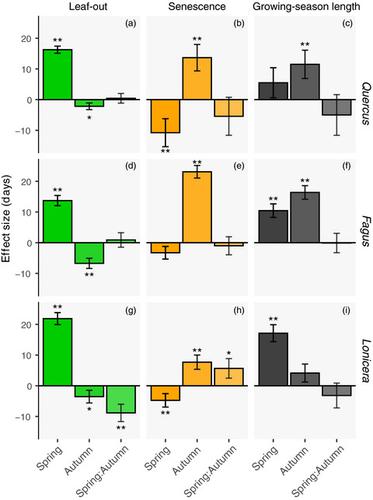Our official English website, www.x-mol.net, welcomes your feedback! (Note: you will need to create a separate account there.)
How changes in spring and autumn phenology translate into growth-experimental evidence of asymmetric effects
Journal of Ecology ( IF 5.5 ) Pub Date : 2021-05-03 , DOI: 10.1111/1365-2745.13682 Constantin M. Zohner 1 , Susanne S. Renner 2, 3 , Veronica Sebald 2 , Thomas W. Crowther 1
中文翻译:

春季和秋季物候变化如何转化为不对称效应的生长实验证据
更新日期:2021-07-09
Journal of Ecology ( IF 5.5 ) Pub Date : 2021-05-03 , DOI: 10.1111/1365-2745.13682 Constantin M. Zohner 1 , Susanne S. Renner 2, 3 , Veronica Sebald 2 , Thomas W. Crowther 1
Affiliation

|
- Earlier leaf-out and later autumn leaf senescence under climate warming have been linked to increases in plant productivity and ecosystem carbon uptake. Yet, despite the potential implications of shifting phenology for plant carbon uptake, the degree to which phenological changes affect overall plant growth and the partitioning between above- and below-ground biomass remains unclear.
- Here we use a 3-year experiment to quantify changes in root and shoot growth of three woody plant species (two common European tree species, Fagus sylvatica and Quercus robur, and one shrub Lonicera xylosteum) under spring and autumn warming.
- In both tree species, the magnitude—and in Quercus even the direction—of the effects of growing-season length on growth depends on whether the warming happened in spring or in autumn. Each day earlier leaf-out in response to warming resulted in total biomass increases of 0.8%–2.5%, whereas delayed senescence led to reductions of 0.2%–2.1%. Advances in leaf-out also led to increased root-to-shoot biomass ratios because root growth was proportionally more stimulated than shoot growth. In the shrub species, earlier leaf-out had no effect, while delayed senescence led to increases in root, but not shoot, biomass.
- Synthesis. The strong asymmetry between growth responses to spring versus autumn phenology demonstrates that growing-season length per se is a weak indicator of individual-level tree productivity. The results further imply that phenological shifts are reshaping the functional balance between above- and below-ground growth, which is critical for quantifying forest carbon dynamics under climate change.
中文翻译:

春季和秋季物候变化如何转化为不对称效应的生长实验证据
- 在气候变暖下,较早的叶片脱落和较晚的秋季叶片衰老与植物生产力和生态系统碳吸收的增加有关。然而,尽管物候变化对植物碳吸收的潜在影响,物候变化影响整体植物生长的程度以及地上和地下生物量之间的分配仍不清楚。
- 在这里,我们使用一个为期 3 年的实验来量化春季和秋季变暖下三种木本植物物种(两种常见的欧洲树种,山毛榉和栎属,以及一种灌木忍冬属植物)的根和枝条生长的变化。
- 在这两种树种中,生长季节长度对生长影响的大小——甚至在栎属植物中的方向——取决于变暖发生在春季还是秋季。为响应变暖,每天提前换叶导致总生物量增加 0.8%–2.5%,而延迟衰老导致减少 0.2%–2.1%。叶出的进展也导致根与地上部生物量比率增加,因为根生长比地上部生长按比例更受刺激。在灌木物种中,较早的叶子脱落没有影响,而延迟衰老导致根部生物量增加,但不会增加枝条生物量。
- 合成。对春季和秋季物候的生长反应之间的强烈不对称表明,生长季节长度本身是个体水平树木生产力的弱指标。结果进一步表明,物候变化正在重塑地上和地下生长之间的功能平衡,这对于量化气候变化下的森林碳动态至关重要。



























 京公网安备 11010802027423号
京公网安备 11010802027423号